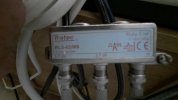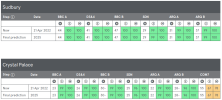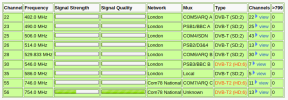-
 The forum software that supports hummy.tv has been upgraded to XenForo 2.3!
The forum software that supports hummy.tv has been upgraded to XenForo 2.3!
Please bear with us as we continue to tweak things, and feel free to post any questions, issues or suggestions in the upgrade thread.
You are using an out of date browser. It may not display this or other websites correctly.
You should upgrade or use an alternative browser.
You should upgrade or use an alternative browser.
Is this the result of splitting the input signal?
- Thread starter makem
- Start date
Black Hole
May contain traces of nut
The signal strength information displayed in WebIF >> Diagnostics >> Mux Info is extracted from the Humax database, and is a snapshot frozen at the time of tuning. If you run an auto-scan, it captures the strength and quality for every mux found, but when you run a manual tune it only records the figures for the last mux tuned... which is why the rest are showing zero. This is an unhelpful "feature" of the Humax implementation.
The only way to get the current figures for strength and quality are to re-run an auto-scan (not recommended, because if signal conditions are not optimum at the time you might lose some muxes, and it kills your recording schedule), or from the HDR-FOX menu: Menu >> Settings >> System >> Signal Detection.
You've been around long enough to know this stuff, but this is like teaching a beginner again.
The only way to get the current figures for strength and quality are to re-run an auto-scan (not recommended, because if signal conditions are not optimum at the time you might lose some muxes, and it kills your recording schedule), or from the HDR-FOX menu: Menu >> Settings >> System >> Signal Detection.
You've been around long enough to know this stuff, but this is like teaching a beginner again.
Last edited:
MymsMan
Ad detector
You can see live signal strength information using the Hidden Settings Menu but you only see one channel at a time
makem
Member
Stop playing silly buggers.
One was clearly done on a manual tune and the other was an automatic one.
Both are probably significantly out of date.
Start from scratch and tune both of them at the same time and then see what you get.
And split how? Using what kit?
I had no intention of playing silly buggers. I don't come here to waste anyone's time - I come with what is to me, a genuine question, the answer to which I don't know. Actually I thought it was signal loss or something caused by splitting the signal from one source across two Humax boxes. It seemed a logical possibility to me although I did wonder why both boxes seemed to be getting reasonable signals.

makem
Member
The signal strength information displayed in WebIF >> Diagnostics >> Mux Info is extracted from the Humax database, and is a snapshot frozen at the time of tuning. If you run an auto-scan, it captures the strength and quality for every mux found, but when you run a manual tune it only records the figures for the last mux tuned... which is why the rest are showing zero. This is an unhelpful "feature" of the Humax implementation.
The only way to get the current figures for strength and quality are to re-run an auto-scan (not recommended, because if signal conditions are not optimum at the time you might lose some muxes, and it kills your recording schedule), or from the HDR-FOX menu: Menu >> Settings >> System >> Signal Detection.
You've been around long enough to know this stuff, but this is like teaching a beginner again.
Sorry if my age is beginning to show. I certainly do feel like a beginner in many subjects I was never taught or needed to learn in depth nowadays, but that goes with age I suppose. I was working full-time using a pencil aged 15.
Quite so. The experts here don't seem to appreciate that many cfw users don't live and breathe the stuff.I don't come here to waste anyone's time - I come with what is to me, a genuine question, the answer to which I don't know.
It's a credit to the developers/maintainers that much of it is so good that it is fit-and-forget, so years can pass before something happens to make you take notice.
Like you I've often forgotten crucial information and have to relearn it to sort things out.
prpr
Well-Known Member
From the data you posted, you would appear to have had adequate signal levels (at the time the data was collected), even after the splitter. The splitter itself is OK. I'm not sure what the state of the connectors or cables are that you have connected to it though. The white one on the left looks kinked, which is not good.Actually I thought it was signal loss or something caused by splitting the signal from one source across two Humax boxes. It seemed a logical possibility to me although I did wonder why both boxes seemed to be getting reasonable signals.
What was the "this" you were complaining about anyway? It is not obvious.
Was it the different number of muxes, the different number of services, the missing signal strength/quality readings or something else?
Luke
Well-Knwοn Мember
It's not clear to me. What am I missing?One was clearly done on a manual tune and the other was an automatic one.
As it is Crystal Palace the second version could have been a manual retune of channel 30 with Network Search set to "On".
That would have resulted in all strength and quality being populated without the help of tunefix, and result in Com7 being missing.
Alternatively could the second version be manual retune with tunefix installed?
The first certainly is. We are approaching the second anniversary of Crystal Palace ceasing transmission of Com8.Both are probably significantly out of date.
prpr
Well-Known Member
The first has had COM8 manually tuned, subsequent to something which populated the rest (we know not what).It's not clear to me. What am I missing?
I don't believe that would give you Local (but admittedly it's a while since I tried it), so in all probability was an automatic tune.As it is Crystal Palace the second version could have been a manual retune of channel 30 with Network Search set to "On"
Who knows. It's kind of irrelevant as it's all old data (the COM8 giveaway). As I said, the actual question was rather woolly, and if trying to find out the current answer to whatever question you need to start with current data, by retuning.That would have resulted in all strength and quality being populated without the help of tunefix, and result in Com7 being missing.
Alternatively could the second version be manual retune with tunefix installed?
Quite.We are approaching the second anniversary of Crystal Palace ceasing transmission of Com8.
makem
Member
'This' being the (for me) total difference in the two results shown in the jpgs. I will do a retune as they were done at different times and I have just seen the comment about tunefix which I need to find out about.From the data you posted, you would appear to have had adequate signal levels (at the time the data was collected), even after the splitter. The splitter itself is OK. I'm not sure what the state of the connectors or cables are that you have connected to it though. The white one on the left looks kinked, which is not good.
What was the "this" you were complaining about anyway? It is not obvious.
Was it the different number of muxes, the different number of services, the missing signal strength/quality readings or something else?
Black Hole
May contain traces of nut
There is some confusion what exactly you are complaining about. I have focused on the "reported" lack of signal in the upper picture, others are focusing on the reduced number of muxes in the lower picture. As I said previously, you cannot rely on those screen grabs as a measure of the current signal, for the reason I have already explained.I have two identical HDR FOX T2 machines which were tuned identically but I get a different result when I examine the signal strengths.
View attachment 6067
View attachment 6068
The only way to get an up-to-date snapshot of the figures for all muxes into that WebIF page is to re-run an auto (not manual) scan – but I do not advise you do that, because (apart from any post-tune patching up you would need to do) if any mux happens to be on the blink at the time of re-tuning you will lose it.
[@prpr: it would be good if there could be a warning message added to WebIF >> Diagnostics >> Mux Info to say something like: "Warning: The indications of Signal Strength and Signal Quality for each multiplex below are a snapshot taken at the time of tuning, only record the multiplex or multiplexes tuned last, and do not represent the current signal conditions. For current signal data please use the Humax menu: Menu >> Settings >> System >> Signal Detection."]
tunefix will have nothing to do with the signal strengths, but it might have something to do with the number of muxes tuned, because the purpose of tunefix is to automate the post-tuning fiddles you might otherwise do manually. In particular, it can be configured to:I have just seen the comment about tunefix which I need to find out about.
- Remove spurious muxes from out-of-area transmitters;
- Remove unwanted muxes;
- Remove unwanted services (eg "adult" channels, incompatible services [MHEG], shopping channels...) ;
- Re-number services (eg make BBC ONE HD "1" instead of "101").
The bottom line is that if you are still getting the TV you want, there is no need to go digging. If, on the other hand, you are trying to solve an actual reception problem, then tell us exactly what the problem is... and above all, don't rely on those screenshots as a measure.
Last edited:
Luke
Well-Knwοn Мember
I have just seen the comment about tunefix which I need to find out about.
It can do in the context of what is reported on the webif for signal strengths.tunefix will have nothing to do with the signal strengths,
Tunefix overwrites zero signal readings in the database with those it cached on the previous reboot. To get accurate figures you should do an auto-tune followed by a reboot to update the cache. Then any subsequent manual tunes which would zero everything apart from the mux. you're tuning will get updated correctly on the next boot.
Black Hole
May contain traces of nut
...but in this case it clearly isn't!It can do in the context of what is reported on the webif for signal strengths.
makem
Member
I really just wanted to know if splitting the signal across two boxes would be an equal split or not. In my ignorance I didn't know if the difference shown reflected an unequal split. I would have been happy with the answer, "No, it is not". Followed perhaps by an explanation of why not.
I now have my answer, thank you all for your input.
As for the tuning guide pointed to:
https://hummy.tv/forum/threads/hdr-fox-t2-tuning-advice.472/page-2#post-5824
I think it needs attention because the web page it points to has been changed.
I also noticed channels with a '-' sign after them and a lot of channels which return no result. I was surprised to see that although Sudbury appeared from the chart to have the best result for my area, in fact it returned less channels than Crystal Palace when tuning.

I now have my answer, thank you all for your input.
As for the tuning guide pointed to:
https://hummy.tv/forum/threads/hdr-fox-t2-tuning-advice.472/page-2#post-5824
I think it needs attention because the web page it points to has been changed.
I also noticed channels with a '-' sign after them and a lot of channels which return no result. I was surprised to see that although Sudbury appeared from the chart to have the best result for my area, in fact it returned less channels than Crystal Palace when tuning.

Last edited:
It frequently changes and I have now updated the post.As for the tuning guide pointed to:
https://hummy.tv/forum/threads/hdr-fox-t2-tuning-advice.472/page-2#post-5824
I think it needs attention because the web page it points to has been changed.
Black Hole
May contain traces of nut
Your photo in post 5 shows a box labelled "2-way splitter" with one connection marked "in" and two connections marked "3.7 dB" (which should actually be "-3.7 dB"), which is the signal power output relative to the input... so: no. A lossless split would be -3.0 dB on each of two outputs, the extra 0.7 dB being the signal loss in the splitter itself. It looks like good-quality kit.I didn't know if the difference shown reflected an unequal split
But, just re-iterating, you haven't shown us any actual "difference" at all, only a misinterpretation of the WebIF Mux Info page.
The value of a properly constructed question.I really just wanted to know if...
Luke
Well-Knwοn Мember
The table for the Crystal Place is if you have an aerial set up for Crystal Palace.I was surprised to see that although Sudbury appeared from the chart to have the best result for my area, in fact it returned less channels than Crystal Palace when tuning.
The table for Sudbury is if you have an aerial set up for Sudbury.
Black Hole
May contain traces of nut
...and it might be better for you to aim at Sudbury, local conditions notwithstanding (like a big building in the way or something), but you won't know unless you redirect your aerial.
Luke
Well-Knwοn Мember
Why?...but in this case it clearly isn't!


